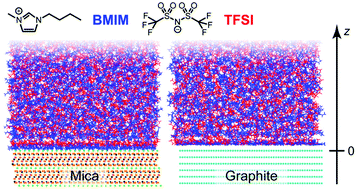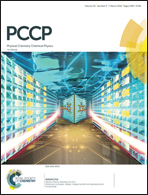Structural and dynamic properties of 1-butyl-3-methylimidazolium bis(trifluoromethanesulfonyl)imide/mica and graphite interfaces revealed by molecular dynamics simulation†
Abstract
It has been observed that the properties of room temperature ionic liquids near solid substrates are different from those of bulk liquids, and these properties play an important role in the development of catalysts, lubricants, and electrochemical devices. In this paper, we report microscopic studies of ionic liquid/solid interfaces performed using molecular dynamics simulations. The structural and dynamic properties of 1-butyl-3-methylimidazolium bis(trifluoromethanesulfonyl)imide (BMIM–TFSI) on mica and graphite interfaces were thoroughly investigated to elucidate the microscopic origins of the formation of layered structures at the interfaces. Our investigation included the observation of structural and orientational changes of ions as a function of distance from the surfaces, and contour mappings of ions parallel and perpendicular to the surfaces. By virtue of such detailed analyses, we found that, during the 5 ns simulation, the closest layer of BMIM–TFSI behaves as a two-dimensional ionic crystal on mica and as a liquid or liquid crystal on graphite.



 Please wait while we load your content...
Please wait while we load your content...